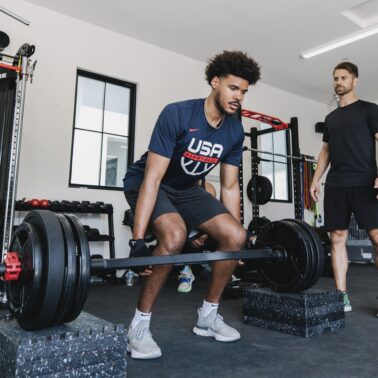“The magnitude of resistance used with running or jumping will manipulate the force-velocity curve and directly impact the duration of ground contact times – a critical component of the return to play process.”
Adam Loiacono
What You Will Learn
- Definition of ground contact times.
- Explore the differences between short and long ground contact times.
- How reducing ground contact times is important during sports rehab.
Running is a fundamental aspect of various sports and an essential component of many rehabilitation programs. Efficient running mechanics play a crucial role in maximizing performance and preventing injuries. One principle of running mechanics and return to play is ground contact time. Ground contact times refers to the duration of time that each foot spends on the ground during each running stride.
Defining Ground Contact Times:
Ground contact time (GCT) is the time period between when your foot initially makes contact with the ground and when it lifts off again to continue the stride. It is typically measured in milliseconds (ms) and varies depending on factors such as running speed, running form, and individual characteristics.
Differentiating Short and Long Ground Contact Times:
Short Ground Contact Times: Short GCTs are typically associated with efficient and high-performance running. When the foot spends minimal time on the ground, the body can utilize the elastic properties of muscles and tendons to store and release energy more effectively. This results in a more propulsive stride, enabling faster running speeds. Athletes with short GCTs exhibit quick and snappy strides, with less time wasted on the ground.
Long Ground Contact Times: Long GCTs are often observed in less efficient running mechanics and can be indicative of potential issues. Prolonged ground contact can be caused by overstriding, inadequate muscle strength or coordination, or poor posture. Long GCTs can lead to a higher risk of injuries and hinder overall running performance. Despite the performance detriments of long GCTs, they are also a great entry point for introducing running drills within sports rehab.
Reducing Ground Contact Times for Sports Rehabilitation:
Reducing ground contact times is not only crucial for optimizing performance but also plays a significant role in sports rehabilitation. Focusing on ground contact times can aid in their recovery and progression.
- Restoring Normal Running Mechanics: During the rehab process, individuals may develop compensatory movement patterns to alleviate pain or protect injured areas. These patterns can lead to altered ground contact times. By analyzing and addressing ground contact times, sports rehabilitation professionals can guide athletes toward restoring normal running mechanics and reducing the risk of re-injury.
- Progressing & Regressing: Longer ground contact times, such as sled pushing or incline running, are great methods to begin to introduce running. The long GTC help the athlete focus on mechanics and limit the magnitude of the impulse during foot strike. Shorter ground contact times reduce the cognitive demand and increase the magnitude of the impulse during the GCT.
- Enhancing Neuromuscular Control: Reducing ground contact times requires coordination and proper timing between muscles and tendons. Sports rehabilitation programs can incorporate drills and exercises that focus on enhancing neuromuscular control, ensuring smooth and efficient transitions during the stance phase of running. This not only aids in injury recovery but also helps prevent future injuries.

Progressing Running Performance:
Beyond rehabilitation, reducing ground contact times can also benefit athletes looking to progress their running performance. By incorporating specific training methods, athletes can actively work on improving their efficiency and running economy.
- Plyometric Training: Plyometric exercises, such as bounding and jumping, can help enhance the stretch-shortening cycle of muscles and tendons. This improves the ability to generate more force and reduces ground contact times. Including plyometric training in a structured program can improve running mechanics and overall performance.
- Technique Analysis and Correction: Working with a physical therapist or performance coach who specializes in running biomechanics can provide valuable insights into an individual’s running form. Through video analysis and real-time feedback, athletes can identify areas for improvement, such as reducing ground contact times. Focusing on proper posture, foot strike, and stride length can lead to more efficient running mechanics.
Summary
Understanding ground contact times and their impact on sports rehab is important for exercise selection. Long GCTs aid in coaching, cueing, and improved postural demands of running. Short GCTs will most closely represent sport and increase the force demands through the body. Both have a key role in sports rehab. Understanding the principles underlying GCTs can help you progress your athletes in a more efficient way.



